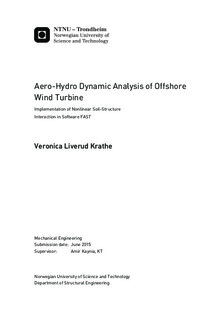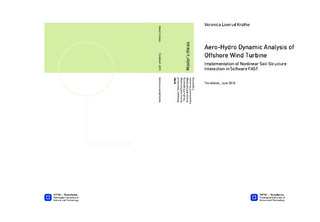| dc.description.abstract | Bottom-mounted offshore wind turbines (OWTs) involve a wide range of engineering fields. Of these, modeling of foundation flexibility has been given little priority. This thesis looks at the modeling of a bottom-mounted offshore wind turbine in the nonlinear aero-hydro-servo-elastic simulation tool FAST v7. The OWT considered is supported on a monopile. The main concern of the thesis was to implement a nonlinear foundation representation in this program. The National Renewable Energy Laboratory's fictitious 5MW reference turbine was used as a base for the analyses.
FAST v7 has an open source code that is written in the programming language Fortran 90. As a base for the execution of the task of this thesis, a thorough understanding of the FAST v7 source code and Fortran was required. Therefore, an introduction to the features and structure of FAST v7 is given. Relevant Fortran codes are presented in the appendices. In addition to FAST v7, NREL provides softwares such as TurbSim and BModes that were utilized. Input files for these are also provided in the appendices.
Moreover, a description of the modeling of environmental loads such as waves and wind, as well as foundation flexibility, is given. The history, current status and terminology of OWTs, in addition to other topics related to wind turbines, such as power generation, natural frequencies and fatigue, are also presented.
Regarding analyses, they are presented over three chapters. First, the base model of the NREL 5MW reference turbine is introduced. Properties of the OWT are given, and typical inputs and outputs are described. Default modeling of foundation in FAST v7 is by means of a rigid foundation, a setting which is kept in this chapter. This implies that soil stiffness and damping is disregarded. Damping may lead to lower design load estimates. A softer foundation, on the other hand, will reduce the natural periods of the system, shifting them closer to the frequencies of the environmental loads. This may in turn lead to amplified moments at the mudline. Therefore, including soil stiffness and damping in the analyses is important.
Correspondingly, the second part concerns a modified version of FAST v7, where coupled linear springs are applied for the modeling of the foundation flexibility. The derivation of an applied foundation stiffness matrix is described. Response of a model with this stiffness is compared with two other models, having a softer and stiffer foundation, respectively.
Finally, a nonlinear foundation is introduced in FAST v7, by means of uncoupled parallel springs. To verify that the implementation was successful, load-displacement curves of the springs are presented. These show the typical hysteresis loops of an inelastic material, which confirms that a nonlinear foundation is implemented. Moreover, constant damping was added in the foundation.
Hence, the conclusion in this thesis is that the objective of implementing a nonlinear foundation representation in FAST v7 was sucessful. | |

